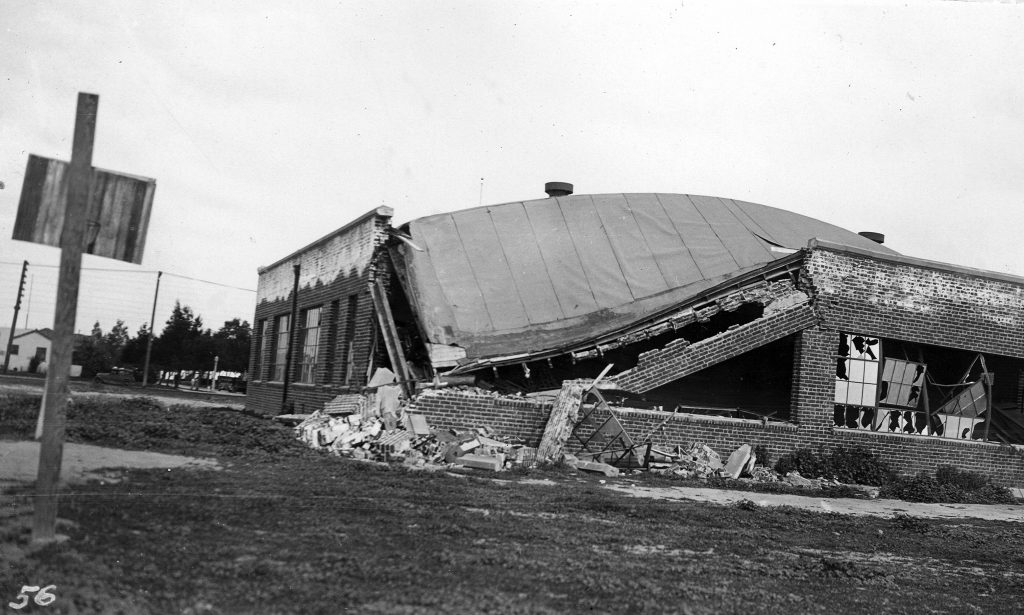4 November 2020–An earthquake of magnitude 8.0 or larger will almost always cause strong shaking, but a new study suggests that smaller earthquakes—those around magnitude 5.5 or so–are the cause of most occurrences of strong shaking at a 60-kilometer (37-mile) distance.
Small earthquakes are expected to produce relatively weak shaking, and for the most part that’s true, said Sarah Minson of the U.S. Geological Survey. However, ground motion is highly variable, and there are always outlier earthquakes at every size that generate more shaking than expected.
Combine that with the fact that there are more smaller magnitude earthquakes than large magnitude earthquakes, and most shaking comes from these “little earthquakes with ambition,” Minson and her colleagues report in Seismological Research Letters.
The researchers found that for all distances and for all levels of shaking, “the earthquakes that cause that level of shaking are systematically smaller magnitude than the earthquakes that should cause that level of shaking,” said Minson, noting that this makes these smaller earthquakes a significant source of earthquake damage.
The findings could change how people think about and prepare for the “Big One,” the large magnitude earthquakes that loom large in the imaginations of people from California to Chile, said Minson.
A future magnitude 8.0 San Andreas Fault earthquake will cause more total damage across the Los Angeles Basin than a smaller, local earthquake like the 1933 magnitude 6.4 Long Beach earthquake, simply because the larger earthquake causes shaking over a wider area. But that just means that there will be more overall shaking, not that the shaking will necessarily be stronger in any particular locality, she explained.

While waiting for the Big One, places like Long Beach are likely to have multiple damaging medium earthquakes, “and thus most damage at any location is probably coming from smaller earthquakes with ambition,” Minson added.
The 1969 Santa Rosa, California earthquakes, around magnitude 6, caused about $50 million damage in today’s dollars, while the magnitude 5.7 Magna, Utah earthquake earlier this year caused similar amounts of damage just to 100 government buildings, the researchers noted.
“For a lot of us, if we do look back over our personal experiences, the earthquake that we had the greatest amount of damage from is not the largest magnitude earthquake that we’ve felt at all,” Minson said.
It’s a “sharks versus cows” concept, she added. “Sharks are scary, and cows are not, but cows kill more people every year than sharks do.”
The researchers began with calculations of the variation of expected ground acceleration from an earthquake of a certain magnitude and distance away from the shaking, along with the well-known Gutenberg-Richter magnitude-frequency relationship. The relationship demonstrates how the frequency of earthquakes decreases as the magnitude grows, so that for each magnitude 8 earthquake that occurs within a given region and time period, there will be 10 magnitude 7 earthquakes, 100 magnitude 6 earthquakes, and so on.
Together, these two factors suggest that most shaking should come from smaller earthquakes that are “ambitious outliers” in terms of the amount of ground acceleration they cause. “The probability of any of these small earthquakes producing shaking is tiny, but there are many of them,” Minson said.
Minson and colleagues confirmed this hypothesis after examining three data sets of earthquakes from across the globe, ranging from magnitude 0.5 to 8.3.
Ambitious little earthquakes may cause difficulty for some earthquake early warning systems, which alert users to potential damaging shaking after an earthquake begins, the researchers write. The closer users are to the earthquake source, the less likely it is that the alert arrives before they feel the shaking.
“If it turns that most of our shaking is coming from smaller magnitude earthquakes, well, smaller magnitude earthquakes are spatially more compact,” Minson said, who noted that some systems also may not send out an alert at all for small earthquakes that aren’t expected to produce damaging shaking.
The findings do not change the total amount of earthquake hazard calculated for a region, Minson stressed. “All we did is say, ok, when that shaking comes, what is it likely to come as? And it’s much more likely to come as little earthquakes with ambition than a big earthquake doing what big earthquakes do.”
This means, as Minson’s UGGS co-author Sara McBride says, that “it’s time to talk about the medium ones.” Surveys and studies show that people often are demotivated by efforts to prepare for the Big One, overwhelmed by fatalism in the face of such an event. Focusing on smaller but significant events could encourage people to devote more time and effort to earthquake preparedness, the researchers suggest.
“If we talk about earthquakes like Loma Prieta and Northridge, and ask people to be prepared for that, it’s more tractable,” Minson said. “Those are the earthquakes that people have experienced and know how to prepare for and survive.”
